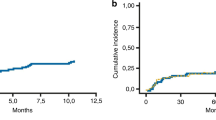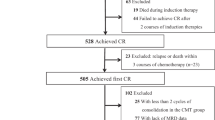Abstract
A retrospective study (n = 460) was performed to assess the relationship between minimal residual disease (MRD) and transplant outcomes in a haplo-stem cell transplantation (SCT) setting. Patients from the pre-MRDneg group and the pre-MRDpos group had comparable outcomes. Compared to post-MRDneg patients, post-MRDpos patients had a higher incidence of relapse (100.0% vs. 8.3%, p < 0.001), lower incidences of overall survival (OS) (16.9% vs. 78.2%, p < 0.001) and leukemia-free survival (LFS) (0% vs. 76.5%, p < 0.001), and comparable probability of NRM (13.4% vs. 16.9%, p = 0.560). In a second set of analyses, all adult AML patients undergoing haplo-SCT were classified into the MRDneg/MRDneg group, the MRD decreasing group, and the MRD increasing group according to MRD dynamics by flow cytometry peri-SCT. Compared to the other two groups, patients from the MRD increasing group had higher cumulative incidences of relapse (MRD increasing, 100.0%; MRDneg/MRDneg, 9.6%; MRD decreasing, 19.2%; p < 0.001) and worse probabilities of OS (MRD increasing, 28.5%; MRDneg/MRDneg, 76.3%; MRD decreasing, 76.0%; p < 0.001) and LFS (MRD increasing, 0.0%; MRDneg/MRDneg, 73.9%; MRD decreasing, 74.0%; p < 0.001). The results indicated that haploidentical allografts might have a beneficial anti-leukemia effect in eradicating pretransplantation MRD, and MRD assessment peri-SCT is useful for risk stratification from a practical perspective.
This is a preview of subscription content, access via your institution
Access options
Subscribe to this journal
Receive 12 print issues and online access
$259.00 per year
only $21.58 per issue
Buy this article
- Purchase on Springer Link
- Instant access to full article PDF
Prices may be subject to local taxes which are calculated during checkout



Similar content being viewed by others
References
Campana D, Leung W. Clinical significance of minimal residual disease in patients with acute leukaemia undergoing haematopoietic stem cell transplantation. Br J Haematol. 2013;162:147–61. https://doi.org/10.1111/bjh.12358
Buckley SA, Appelbaum FR, Walter RB. Prognostic and therapeutic implications of minimal residual disease at the time of transplantation in acute leukemia. Bone Marrow Transplant. 2013;48:630–41. https://doi.org/10.1038/bmt.2012.139
Hourigan CS, Karp JE. Minimal residual disease in acute myeloid leukaemia. Nat Rev Clin Oncol. 2013;10:460–71. https://doi.org/10.1038/nrclinonc.2013.100
Freeman SD, Virgo P, Couzens S, Grimwade D, Russell N, Hills RK, et al. Prognostic relevance of treatment response measured by flow cytometric residual disease detection in older patients with acute myeloid leukemia. J Clin Oncol. 2013;31:4123–31. https://doi.org/10.1200/JCO.2013.49.1753
Walter RB, Gyurkocza B, Storer BE, Godwin CD, Pagel JM, Buckley SA, et al. Comparison of minimal residual disease as outcome predictor for AML patients in first complete remission undergoing myeloablative or nonmyeloablative allogeneic hematopoietic cell transplantation. Leukemia. 2015;29:137–44. https://doi.org/10.1038/leu.2014.173
Zhou Y, Othus M, Araki D, Wood BL, Radich JP, Halpern AB, et al. Pre- and post-transplant quantification of measurable (“minimal”) residual disease via multiparameter flow cytometry in adult acute myeloid leukemia. Leukemia. 2016;30:1456–64. https://doi.org/10.1038/leu.2016.46
Walter RB, Buckley SA, Pagel JM, Wood BL, Storer BE, Sandmaier BM, et al. Significance of minimal residual disease before myeloablative allogeneic hematopoietic cell transplantation for AML in first and second complete remission. Blood. 2013;122:1813–21. https://doi.org/10.1182/blood-2013-06-506725
Oran B, Jorgensen JL, Marin D, Wang S, Ahmed S, Alousi AM, et al. Pre-transplantation minimal residual disease with cytogenetic and molecular diagnostic features improves risk stratification in acute myeloid leukemia. Haematologica. 2017;102:110–7.
Chang Y-J, Wang Y, Liu Y-R, Xu L-P, Zhang X-H, Chen H, et al. Haploidentical allograft is superior to matched sibling donor allograft in eradicating pre-transplantation minimal residual disease of AML patients as determined by multiparameter flow cytometry: a retrospective and prospective analysis. J Hematol Oncol. 2017;10:134.
Chang YJ, Zhao XS, Wang Y, Liu YR, Xu LP, Zhang XH et al. Effects of pre- and post-transplantation minimal residual disease on outcomes in pediatric patients with acute myeloid leukemia receiving human leukocyte antigen-matched or mismatched related donor allografts. Am J Hematol. 2017. https://doi.org/10.1002/ajh.24910
Wang Y, Liu QF, Xu LP, Liu KY, Zhang XH, Ma X, et al. Haploidentical vs identical-sibling transplant for AML in remission: a multicenter, prospective study. Blood. 2015;125:3956–62. https://doi.org/10.1182/blood-2015-02-627786
Del Vecchio L, Brando B, Lanza F, Ortolani C, Pizzolo G, Semenzato G, et al. Recommended reporting format for flow cytometry diagnosis of acute leukemia. Haematologica. 2004;89:594–8.
Feller N, van der Velden VH, Brooimans RA, Boeckx N, Preijers F, Kelder A, et al. Defining consensus leukemia-associated immunophenotypes for detection of minimal residual disease in acute myeloid leukemia in a multicenter setting. Blood Cancer J. 2013;3:e129 https://doi.org/10.1038/bcj.2013.27
Przepiorka D, Weisdorf D, Martin P, Klingemann HG, Beatty P, Hows, et al. 1994 Consensus Conference on Acute GVHD Grading. Bone Marrow Transplant. 1995;15:825–8.
Filipovich AH, Weisdorf D, Pavletic S, Socie G, Wingard JR, Lee SJ, et al. National Institutes of Health consensus development project on criteria for clinical trials in chronic graft-versus-host disease: I. Diagnosis and staging working group report. Biol Blood Marrow Transplant. 2005;11:945–56. https://doi.org/10.1016/j.bbmt.2005.09.004
Wang Y, Liu DH, Xu LP, Liu KY, Chen H, Chen YH, et al. Superior graft-versus-leukemia effect associated with transplantation of haploidentical compared with HLA-identical sibling donor grafts for high-risk acute leukemia: an historic comparison. Biol Blood Marrow Transplant. 2011;17:821–30. https://doi.org/10.1016/j.bbmt.2010.08.023
Luo Y, Xiao H, Lai X, Shi J, Tan Y, He J, et al. T-cell-replete haploidentical HSCT with low-dose anti-T-lymphocyte globulin compared with matched sibling HSCT and unrelated HSCT. Blood. 2014;124:2735–43. https://doi.org/10.1182/blood-2014-04-571570
Casucci M, Perna SK, Falcone L, Camisa B, Magnani Z, Bernardi M, et al. Graft-versus-leukemia effect of HLA-haploidentical central-memory T-cells expanded with leukemic APCs and modified with a suicide gene. Mol Ther. 2013;21:466–75. https://doi.org/10.1038/mt.2012.227
Yan C, Liu D, Liu K, Xu L, Liu Y, Chen H, et al. Risk stratification-directed donor lymphocyte infusion could reduce relapse of standard-risk acute leukemia patients after allogeneic hematopoietic stem cell transplantation. Blood. 2012;119:3256–62.
Yan CH, Wang Y, Wang JZ, Chen YH, Chen Y, Wang FR, et al. Minimal residual disease- and graft-vs.-host disease-guided multiple consolidation chemotherapy and donor lymphocyte infusion prevent second acute leukemia relapse after allotransplant. J Hematol Oncol. 2016;9:87 https://doi.org/10.1186/s13045-016-0319-5
Dao MA AJ, Nolta JA. Reversibility of CD34 expression on human hematopoietic stem cells that retain the capacity for secondary reconstitution. Blood. 2003;101:112–8.
Hess DA, Karanu FN, Levac K, Gallacher L, Bhatia M. Coculture and transplant of purified CD34(+)Lin(−) and CD34(−)Lin(−) cells reveals functional interaction between repopulating hematopoietic stem cells. Leukemia. 2003;17:1613–25. https://doi.org/10.1038/sj.leu.2403028
Sato TLJ, Ogawa M. Reversible expression of CD34 by murine hematopoietic stem cells. Blood. 1999;94:2548–54.
Tajima F, Deguchi T, Laver JH, Zeng H, Ogawa M. Reciprocal expression of CD38 and CD34 by adult murine hematopoietic stem cells. Blood. 2001;97:2618–24.
Guo Z, Gao HY, Zhang TY, Liu XD, Yang K, Lou JX, et al. Analysis of allogeneic hematopoietic stem cell transplantation with high-dose cyclophosphamide-induced immune tolerance for severe aplastic anemia. Int J Hematol. 2016;104:720–8.
How J, Slade M, Vu K, Dipersio JF, Westervelt P, Uy GL, et al. T cell-replete haploidentical transplantation with post-transplantation cyclophosphamide for hodgkin lymphoma relapsed after autologous transplantation: reduced incidence of relapse and of chronic graft-versus-host disease compared with HLA-identical related donors. Biol Blood Marrow Transplant. 2017;24:627–32.
Acknowledgments
We thank all the faculty members that participated in these studies. We would also like to thank American Journal Experts (www.aje.com) for the assistance in editing this manuscript.
Author contributions
Contribution: Y.-J.C. designed the study; J. L, R. M, and Y.-J.C. collected data; J. L and Y.-J.C. analyzed the data and drafted the manuscript; all authors contributed to data interpretation, manuscript preparation, and approval of the final version.
Author information
Authors and Affiliations
Corresponding author
Ethics declarations
Conflict of interest
The authors declare that they have no conflict of interest.
Electronic supplementary material
Rights and permissions
About this article
Cite this article
Liu, J., Ma, R., Liu, YR. et al. The significance of peri-transplantation minimal residual disease assessed by multiparameter flow cytometry on outcomes for adult AML patients receiving haploidentical allografts. Bone Marrow Transplant 54, 567–577 (2019). https://doi.org/10.1038/s41409-018-0300-8
Received:
Revised:
Accepted:
Published:
Issue Date:
DOI: https://doi.org/10.1038/s41409-018-0300-8
This article is cited by
-
MRD positivity was the poor prognostic factor for adverse-risk AML patients with allogeneic hematopoietic stem cell transplantation: a multicenter TROPHY study
Blood Cancer Journal (2024)
-
Allogeneic hematopoietic stem cell transplantation for adult acute myeloid leukemia patients with nucleoporin 98 (NUP98) gene rearrangements: a real-world study in China
Bone Marrow Transplantation (2023)
-
Improved Vδ2+ T cells recovery correlates to reduced incidences of mortality and relapse in acute myeloid leukemia after hematopoietic transplantation
Annals of Hematology (2023)
-
Prognostic prediction of novel risk scores (AML-DRG and AML-HCT-CR) in acute myeloid leukemia patients with allogeneic hematopoietic stem cell transplantation
Scientific Reports (2022)
-
Impact on outcomes of mixed chimerism of bone marrow CD34+ sorted cells after matched or haploidentical allogeneic stem cell transplantation for myeloid malignancies
Bone Marrow Transplantation (2022)



